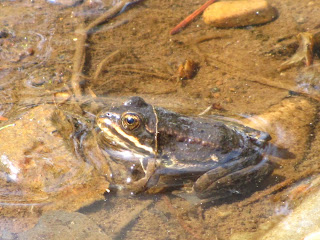Beehives that is! This week I have gone from owning two hives to three. My two over-wintered hives are boiling with bees and filling with new brood and it's getting mighty crowded. The only way bees can make room in the hive is by swarming which is good for the bees but not such a happy event for a beekeeper. Suddenly you lose your mature, egg-laying queen and she takes half the colony with her.
Though it can occur anytime during spring, summer and fall, May is the beginning of swarming season here in North Idaho. One way to prevent swarming is to remove a three to four frames of brood along with the bees on those frames and replace them with frames that either consist of drawn comb or new foundation. But incredable thing about removing the frames of brood is that you can place those frames in a new hive and start an additional colony of bees.
The new hive is often called a "split". You have (hopefully) preempted a swarm from occurring and have a new colony of bees that would cost you anything from $75 to $125 to buy.
Now you may ask "But where do you get a new queen?" This is the really cool part: The new colony will "make" one! The main ingredient to make a new queen from this split hive are frames of "open" brood. When the bee larvae are developing in their cells, they are tended by the working bees and are eventually sealed in their chambers to pupate and emerge as worker bees.
When a colony of bees senses that it is queenless, it can take brood that is young enough and transform it to a larva that will develop into a queen instead of worker. They feed the larva royal jelly to create a queen. So when picking out frames from the main colony to create the split it's imperative to select frames that contain freshly laid eggs.
A new queen will be raised and eventually she will leave the hive on her mating flight. She will return to the split hive she was raised in and start laying eggs which will grow into workers for the hive. The new split hive that started three days is the striped one on the right.
Another factor that will insure the success of the new hive is plenty of young bees. Older, foraging bees that know what it's like to be outside of the hive will return to their original hive since they consider it home. But all the young bees that were moved to the split hive do not know what their hive looks like from the outside yet. When they become old enough to start foraging in the outside world they will consider this hive their home.
In the next few days, I'm going to make a split off the other over-wintered hive and it's going into this ugly hive. Each hive in my bee yard has a different paint job to help the bees recognize and imprint on their home. If I had all plain hives so close together there is a possibility of what's known as "drift" where bees move between hives thinking they are returning to their regular hive. This can result in hives that are stronger than others for no other reason than bees are going to the wrong hive.
I'm hoping my next split goes well. Wish me luck!
























































